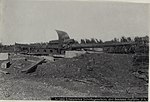Cannone da 152/45
| Cannone da 152/45 | |
|---|---|
 Cannone da 152/45's on pedestal mounts at the Ansaldo factory. | |
| Type | Naval gun Coastal artillery Siege gun |
| Place of origin | Kingdom of Italy |
| Service history | |
| In service | 1917-1945 |
| Used by | Kingdom of Italy |
| Wars | World War I World War II |
| Production history | |
| Manufacturer | Ansaldo |
| Specifications | |
| Mass | Naval gun: 7.1 t (7 long tons) Siege gun: 16.67 t (16.41 long tons) |
| Barrel length | 7.138 m (23 ft 5 in) L/46.7 |
| Shell | Separate loading bagged charge and projectile |
| Shell weight | 47 kg (104 lb) |
| Caliber | 152.4 mm (6 in) |
| Breech | Welin breech block |
| Recoil | Hydro-spring |
| Carriage | Box trail |
| Elevation | -5° to +45° |
| Traverse | Casemate: 60° Siege gun: 10° |
| Rate of fire | 1 rpm |
| Muzzle velocity | 830 m/s (2,700 ft/s) |
| Maximum firing range | 19.4 km (12 mi) |
The Cannone da 152/45 modello 1911 was an Italian Naval Gun built by the Ansaldo company. It formed the secondary armament of the two Andrea Doria class dreadnought battleships built during World War I. A number of guns were also converted to siege artillery and coastal artillery roles and served during both world wars.
Variants[]
- Coastal artillery - An unknown number of guns were mounted on shielded pedestal mounts as coastal artillery during both world wars.[1]
- Naval artillery - The secondary armament of this class of two ships consisted of sixteen 45-caliber 152-millimeter (6 in) guns, mounted in single casemates along the sides of the hull underneath the main guns.[2] These guns could traverse 60 degrees, depress to −5 degrees and had a maximum elevation of +20 degrees. The gun mounts had a reputation of being wet in heavy seas and when the ships were modernized these gun positions were removed and the surplus guns were redeployed.[3]
- Siege artillery - This version consisted of mounting surplus barrels on a large box trail carriage to address the Italian Army's need for siege artillery and long-range counter-battery work. The carriage had a large open section in the middle that allowed the gun to reach high angles of elevation. In order to deploy the guns a large pit had to be dug to allow the breech to recoil and this also allowed the gun crew to service the gun's breech. At the front of the pit, there was a platform to anchor the gun which also allowed for limited traverse. 53 were in Italian service in 1939 mostly in Northern Italy. The German designation for the gun was the 15.2 cm K 411(i).[4]
Photo Gallery[]
| Wikimedia Commons has media related to Cannone da 152/45. |

A 152/45 at Monte Sabatino in 1917.

A 152/45 captured by Austro-Hungarian forces.

A 152/45 on its firing platform
References[]
- ^ "2170 – CANNONE da 152/45 S. 1911 per postazioni a terra | Associazione Navimodellisti Bolognesi". www.anb-online.it (in Italian). Retrieved 1 July 2018.
- ^ Friedman, Norman (2011). Naval weapons of World War One : guns, torpedoes, mines and ASW weapons of all nations : an illustrated directory. S. Yorkshire: Seaforth Pub. p. 240. ISBN 9781848321007. OCLC 751804655.
- ^ Gardiner, Robert (1985). Conway's All the World's Fighting Ships, 1906–1921. Gray, Randal. Annapolis, Md.: Naval Institute Press. p. 260. ISBN 0870219073. OCLC 12119866.
- ^ Chamberlain, Peter (1975). Heavy artillery. Gander, Terry. New York: Arco. ISBN 0668038985. OCLC 2143869.
Categories:
- World War I guns
- World War II field artillery
- Artillery of Italy
- World War II artillery of Italy
- Naval guns of Italy
- 152 mm artillery
- Gio. Ansaldo & C. artillery
- Artillery stubs


